授课教师
| 李绮琪
| 学校、年级
| 广东省江门市棠下中学
|
课型
| 听说课
| 时长
| |
教学设计理念
|
本节课基于英语学习活动观的六个层次的活动设计,分别为:一、围绕主题创设语境,激活已知,提出问题;二、梳理细节信息获取新知识,弥补认识偏差;三、概括、整合、重组信息,形成跟主题意义相关的新的认知;四、对于与主题的关联信息进行整合性的阐述、输出、表达,开展语言实践活动;五、分析语言结构和进行语言形式与主题意义的关联,在情境中感受语言的使用,加深理解和欣赏语言;六、将所学的知识和能力迁移到新的生活情境中解决真实的问题。在单元整体教学的背景下,本课时设计关注学生的探究过程,关注学生的结构化知识是否形成或得到发展,促使学生在活动中以合作和探究的方式获得知识、丰富经验、发展技能、提高能力、养成健康人格,强调学生之间的相互促进和共同提高。
|
文本解读
|
首先是一篇有关外语学习的演讲,内容主要包括联合国使用的官方语言的介绍和学生选择学习外语的原因,旨在训练学生能够提取目标信息,通过完成题目来梳理信息,从而对听力语篇形成较完整的理解。该篇演讲使用了一般将来时来介绍联合国使用的官方语言,使用了一般过去式来介绍学生选择学习外语的原因。通过对关键信息的获取,学生还需要注意到代词的指代作用和转折连词所起到的先抑后扬的语用功能。
其次是一篇关于外语学习者的泛读文章,内容是介绍通晓数种语言者他们的共同之处以及其中一名外语学习者Tim Doner学习希伯来语的经历,以夹叙夹议的形式介绍语言学习的方法和经历,以及学习外语的收获。
|
学情分析
|
学生生活在多元文化下对我们所处的环境有一定的了解,能够基本了解英语使用在国际的位置,但对其他语言作为官方语言的使用知之甚少,英语表达的能力也有待提高。对听力材料有获取有用信息的基本能力,能够获取文本的基本大意,但可能会错过部分关键信息,还需要一定的精听训练增强对文本信息的处理能力。
|
教学目标
|
学习理解:
1. Talk about some countries and the languages spoken in these countries;
2. Get main idea, details, and inference as well as identify pronouns and what they refer to;
3. Focus on key words, not on single words or grammar.
应用实践:
4. Talk about which foreign language you want to learn and why.
迁移创新:
5. Master some successful methods in language learning.
|
教学重难点
|
Main learning focus:
1. Talk about some countries and the languages spoken in these countries;
2. Get main idea, details, and inference as well as identify pronouns and what they refer to;
3. Focus on key words, not on single words or grammar.
Potential difficulties:
4. Talk about which foreign language you want to learn and why.
5. Master some successful methods in language learning.
|
教学资源
|
课件PPT,黑板、白板。
|
教学目标
| 活动形式与步骤
| 活动意图
| 活动
层次
| 时间
|
目标一:听懂一个有关外语学习的演讲并完成信息定位、回答相关问题等听后任务;
| Step 1 Leading in
- Present two quotos to ask whether students can understand the meaning.
One language sets you in a corridor (通道) for life. Two languages open every door along the way.
Step 2 Before listening
- Ask students the following questions before listening.
Q: How many countries are there in the world?
Q: How many languages are there in the world?
Q:What are the official languages in the United Nations?
Q: Which is the most difficult language to learn in the world?
Q: How do people say “Hello!” in other countries?
(watch a video)
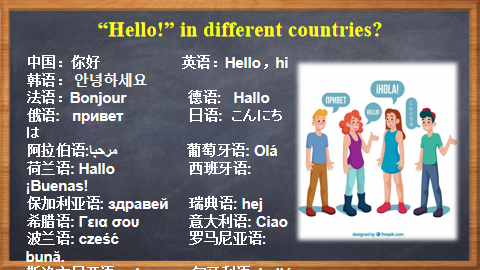
Q: What countries do the photos stand for?
Q: Which languages are spoken in these countries?
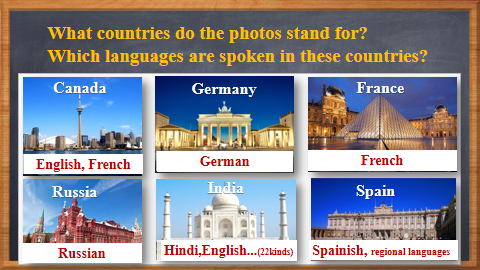
| 通过一个引出语篇主题,激发学生兴趣。
通过问题链引导学生进行更深入的探讨,学生能够对相应话题和词汇更为熟悉,为后续观看视频做好铺垫。
| 感知与注意
感知与注意
| 3mins
5mins
|
目标二:基于听的任务基础上,完成说的输出性任务,讨论想学的外语和原因;
目标三:了解通晓数种语言的人学习的经历;
| Step3 While reading
- Listen to a speech and tick the two languages with the most native speakers.
- Listen to a speech and circle the official languages of the United Nations [UN].
- Listen to the speech again. And answer the questions.
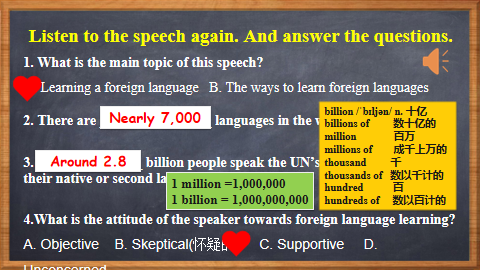
- Listen to part of the speech and fill in the blanks.
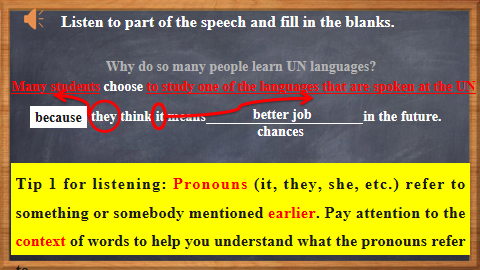
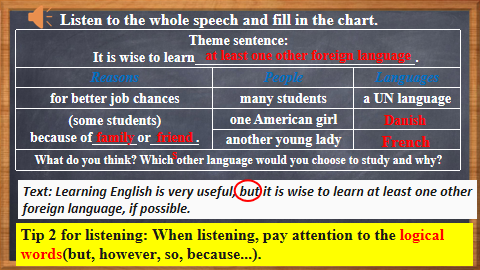
5.Watch a video about Wang Yuan’s presentation in UNICEF
| 通过前两轮听力完成相应的练习,引导学生对联合国的官方语言有进一步了解,拓展了文化视野,为后续为后续的口头输出活动铺垫思考方式和内容。
通过第三轮听力训练,引导学生在听力过程中还需要注意到代词的指代作用和转折连词所起到的先抑后扬的语用功能。
| 感知与注意
概括与整合
| 5mins
5mins
|
| Step 3 Post-listening
- Read the following sentences and figure out more reasons why students choose the specific language to learn.
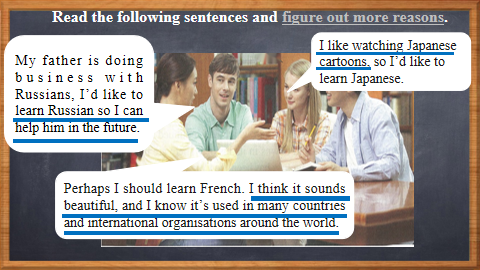
- Ask students some questions about the extensive reading---Polyglots.
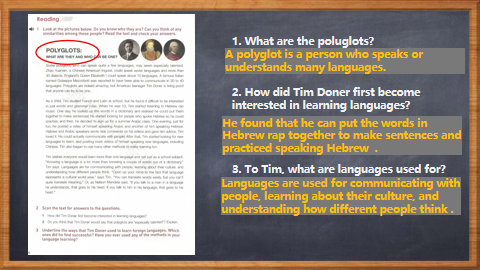
Step4 Discussion
Discussing: Which foreign language would you like to choose? Why?
Task: Make a conversation about this topic

Step5 : Homework
Make a video to attract foreigners to learn Chinese and post it on TikTok. In your video:
- you should make a conversation with your friend about this topic;
- you should add pictures with Chinese features.
| 在老师的引导下组织语言谈论选择外语学习的话题
通过问题让学生整合泛读材料中的关键信息,有助于对外语学习的主题进行深层次的理解。
学生扮演角色,进行口语对话,分享自己选择外语学习动机和经历。利用听力材料和泛读文本的与主题相关的词汇表达进行对话练习,提高语言表达能力,培养学生的表达能力,提高学生学习英语的兴趣
创作产出阶段:根据提供的提示问题及前期搭好的框架,学生创造性的录一段关于学习中文的视频放到抖音上。
| 概括与整合
概括与整合
概括与整合、描述与阐述
内化与应用、
想象与创造
| 2mins
5mins
10mins
|
![]() 川公网安备51152402000101号 )|网站地图
川公网安备51152402000101号 )|网站地图